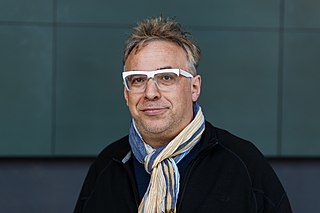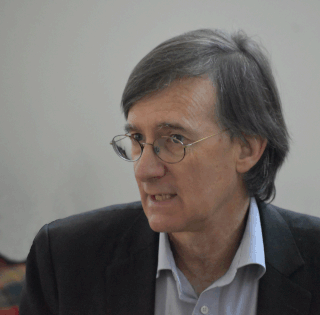
Hermeneutics is the theory and methodology of interpretation, especially the interpretation of biblical texts, wisdom literature, and philosophical texts. Hermeneutics is more than interpretative principles or methods used when immediate comprehension fails and includes the art of understanding and communication.

Donald Alan Schön was an American philosopher and professor in urban planning at the Massachusetts Institute of Technology. He developed the concept of reflective practice and contributed to the theory of organizational learning.

Lev Manovich is an author of books on digital culture and new media, and professor of Computer Science at the Graduate Center, City University of New York. Manovich's current research and teaching focuses on digital humanities, social computing, new media art and theory, and software studies.

Kevin Andrew Lynch was an American urban planner and author. He is known for his work on the perceptual form of urban environments and was an early proponent of mental mapping. His most influential books include The Image of the City (1960), a seminal work on the perceptual form of urban environments, and What Time is This Place? (1972), which theorizes how the physical environment captures and refigures temporal processes.
Phenomenology in architecture can be understood as a discursive and realist attempt to understand and embody the philosophical insights of phenomenology.

Eduardo Fernando Catalano was an Argentine architect.
Colin Rowe, was a British-born, American-naturalised architectural historian, critic, theoretician, and teacher; he is acknowledged to have been a major theoretical and critical influence, in the second half of the twentieth century, on world architecture and urbanism. During his life he taught briefly at the University of Texas at Austin and, for one year, at the University of Cambridge in England. For most of his life he was a professor at Cornell University in Ithaca, New York. Many of Rowe’s students became important architects and extended his influence throughout the architecture and planning professions. In 1995 he was awarded the Gold Medal by the Royal Institute of British Architects, its highest honour. He was also awarded the Athena Medal from the Congress for the New Urbanism posthumously in 2011.
Materiality in architecture is a concept or the applied use of various materials or substances in the medium of building. This concept was previously regarded as a secondary consideration in architecture but recently emerged as an important element due to advances in digital fabrication and digital science.

The MIT School of Architecture and Planning is one of the five schools of the Massachusetts Institute of Technology, located in Cambridge, Massachusetts. Founded in 1865 by William Robert Ware, the school offered the first formal architectural curriculum in the United States, and the first architecture program in the world operating within the establishment of a university. MIT SAP is considered a global academic leader in the design fields and one of the most prestigious schools in the world. MIT's department of architecture has consistently ranked among the top architecture/built environment schools in the world, and from 2015 to 2018 was ranked highest in the world in QS World University Rankings. In 2019, it was ranked second to The Bartlett but regained the number one position in the 2020 rankings.

N. John Habraken is a Dutch architect, educator, and theorist. His theoretical contributions are in the field of user participation in mass housing, the integration of users and residents into the design process. The visual result of his theory is the architecture of lively variety. Habraken is the initiator of the international "Participation movement" in architecture. His book "Supports: An Alternative to Mass Housing", first published in 1961, is the manifesto and starting point of this movement. The theme "Resident or user participation" has been linked to Structuralism and Open building.
Dean Hawkes is a British architect and award-winning academic. Born in 1938 he studied at Regional College of Art, Manchester and Clare College, University of Cambridge. His career combined practice, teaching and research:

Alexander Tzonis is a Greek-born architect, author, and researcher. He has made contributions to architectural theory, history and design cognition, bringing together scientific and humanistic approaches in a synthesis. Since 1975, he has been collaborating in most projects with Liane Lefaivre. In 1985, he founded and directed Design Knowledge Systems (DKS), a multidisciplinary research institute for the study of architectural theory and the development of design thinking tools at TU Delft. Tzonis is known for his work on the classical canon, history of the emergence and development of modern architectural thinking, creative design by analogy, and introducing the idea of critical regionalism.

Jeff Malpas is an Australian philosopher and emeritus distinguished professor at the University of Tasmania in Hobart. Known internationally for his work across the analytic and continental traditions, Malpas is also at the forefront of contemporary philosophical research on the concept of "place", as first and most comprehensively presented in his Place and Experience: A Philosophical Topography—now in its second edition—and further developed in numerous subsequent works.
David Leatherbarrow is Professor of Architecture and Chair of the Graduate Group in Architecture at the University of Pennsylvania School of Design, Philadelphia, where he has taught since 1984. He received his B.Arch. from the University of Kentucky and holds a Ph.D. in Art from the University of Essex. He has also taught in England, at Cambridge University and the University of Westminster.
Stéphan Barron was the first to develop the concept of Technoromanticism between 1991 and 1996 for his doctoral thesis at the University Paris VIII. The main theme of his research is what he calls “Technoromantisme/Technoromanticism”, a neologism which he created and which has been adopted by other English-speaking researchers. Technoromanticism is the theory of links between art and new technologies, within the context of the threats posed to nature by technoscience and economic development. Technoromanticism also seeks to analyse the return of the human body within technological arts, formulating the hypothesis that a technological society needs a corporeal rebalancing of perceptions. Delayed for editorial reasons, his book Technoromantisme was published by l'Harmattan in 2003. Technoromanticism is a term used to indicate those aspects of contemporary culture that ascribe to advanced technologies the capacity to promote the power of the imagination, to restore the role of genius and to bring about a unity; in other words that revive and perpetuate the legacy of the eighteenth- and nineteenth-century artistic and philosophical movement known as Romanticism, but by technological means. The term was used in 1999 in a book that bore the title Technoromanticism outlining evidence of romanticism in many commentaries on digital technology at the time.
Adrian Snodgrass is an Australian architect and scholar in Buddhist studies and Buddhist art. He has developed theories in the area of hermeneutical philosophy and its application to knowledge production and cross-cultural understanding. Snodgrass is co-editor of the journal Architectural Theory Review and Editor of Architectural Theory.
Robert Tavernor is an English Emeritus Professor of Architecture and Urban Design at the London School of Economics and Political Science (LSE), and founding director of the Tavernor Consultancy in London. He is an architecture historian and urbanist, who has published widely on architecture and urban design, including the impact of tall buildings on historic cities. His long academic career includes being appointed to the Forbes Chair in Architecture at the University of Edinburgh at age 36.
Critical code studies (CCS) is an emerging academic subfield, related to software studies, digital humanities, cultural studies, computer science, human–computer interface, and the do-it-yourself maker culture. Its primary focus is on the cultural significance of computer code, without excluding or focusing solely upon the code's functional purpose. According to Mark C. Marino, it
is an approach that applies critical hermeneutics to the interpretation of computer code, program architecture, and documentation within a socio-historical context. CCS holds that lines of code are not value-neutral and can be analyzed using the theoretical approaches applied to other semiotic systems in addition to particular interpretive methods developed particularly for the discussions of programs.
Liane Lefaivre, a Canadian and an Austrian, is o-Professor of Architectural History and Theory at the University of Applied Art in Vienna Austria, now retired.
Anastasia Loukaitou-Sideris is a Greek-American academic. She is a Distinguished Professor of urban planning and urban design at UCLA. She is also a core faculty of the UCLA Urban Humanities Initiative. She served as Associate Provost for Academic Planning at UCLA from 2016-2019, and she has been the Associate Dean of the UCLA Luskin School of Public Affairs since 2010. She was the chair of the UCLA Department of Urban Planning from 2002-2008. She is a public space scholar and has examined transformations in the public realm and public space in cities, and their associated social meanings and impacts on urban residents. An underlying theme of her research is its user focus, as it seeks to comprehend the built environment from the perspective of different, often vulnerable, user groups.








